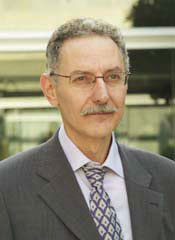 by Kostas Glinos, European Commission, DG Information Society and Media
by Kostas Glinos, European Commission, DG Information Society and Media
Head of GEANT and e- Infrastructure Unit
Scientific computing is today becoming the 'third pillar' of scientific inquiry, alongside the more traditional theory and experimentation pillars. At the same time, tough policy choices in the grand challenge areas of our time like energy, the environment, climate and health, will need to be increasingly grounded in Science in order to be effective and justifiable. The availability of high capability systems and simulation software therefore becomes a condition for both competitive Science and sound policy-making. The ongoing evolution towards an integrated European HPC (high performance computing) and computational science infrastructure from scattered national investments now offers Europe the possibility to take a leading position in scientific computing.
HPC systems exhibiting a very high level of parallelism and attaining performances of one or more peta-flops (A peta-flops is the equivalent to ten to the power of fifteen FLoating point Operations Per Second. The peta-flops barrier is the most recently surpassed performance barrier in HPC systems.) are already being deployed. This is an engineering achievement in terms of balancing performance increases with acceptable power consumption. On the other hand, efficiently exploiting such systems with well-tuned application codes and tools is still a challenge for computational science. In addition, steeply increasing costs for HPC systems and specialised hardware are expected to result in an increasing use of commodity components and shift added value from hardware to software.
In fact, the cost of acquiring and operating a national leadership-class HPC facility, with the periodic investments in hardware, energy and operations, is becoming too high for most European countries to justify bearing it alone. The cost of tuning codes to exploit the stated increases in computing performance is also not negligible. In this context, a consortium of national supercomputing centres decided to form a partnership to create a European HPC infrastructure service composed of leadership-class HPC systems and centres of excellence in computational sciences with the mandate to procure and operate the systems as well as to support users in addressing Grand Challenge problems. This partnership, code-named PRACE (See also more details on PRACE (Partnership for Advanced Computing in Europe) at http://www.prace-project.eu), is soon to create an organisation that will provide HPC services with funding from several European countries and from the European Union.
Over the previous years, EU support to HPC took the form of: (i) consolidating a distributed infrastructure of national HPC facilities (See also for more details the project DEISA (Distributed European Infrastructure for Supercomputing Applications) at http://www.deisa.eu) and (ii) co-ordinating the access of the scientific and engineering community to the computing slots available via a common resource pool (The DEISA Extreme Computing Initiative (DECI in short) calls for proposals (see also http://www.deisa.eu/science/deci)). This 'grid' of HPC systems soon became a success with the European computational science community; the services and competence of the infrastructure provider filled a gap, serving many European researchers without national HPC facilities of sufficient performance or without the best match of system architecture to their codes. A policy group was thus formed that called on the European Union to support the creation of a new research infrastructure focussed on the provision of leadership-class systems at the same level as the US and Japan and access to the facility based on scientific merit (See also the policy work of the European HPC task force (http://www.hpcineuropetaskforce.eu) and the roadmap of new European research infrastructures produced by the ESFRI in 2006 (http://cordis.europa.eu/esfri/roadmap.htm)). Thanks to the work of this policy group, the European HPC service was included in the 2006 ESFRI Roadmap for Research Infrastructures which, in turn, led to the European Union strongly contributing to these developments via the Capacities programme (The Capacities Programme aims to enhance research and innovation capacities throughout Europe and ensure their optimal use. It is one of the specific programs of the Seventh Framework Programme (FP7) for research and development (see also the site: http://cordis.europa.eu/fp7/faq_en.html)).
This process opened a path for progressive convergence of national and EU policies on the strategy for investments in HPC infrastructure. The aim is that the European HPC infrastructure becomes an integrated distributed facility that enables access to computing resources as required by scientific or engineering applications, supporting innovation and scientific breakthroughs and the attractiveness of Europe for research.
In parallel to these activities, the e-infrastructures part of the EU's framework programme has provided support to other ICT-based infrastructure such as the high-speed network GÉANT that interconnects supercomputing centres and the distributed computing grid of EGEE (and soon EGI). Recent additional investments in scientific software, regional HPC facilities and data e-infrastructures complement and enhance the European HPC infrastructure support.
For the vision of EU leadership in HPC to become reality, a number of policy, research and technical challenges still need to be addressed. First, the combined purchasing power of European countries for leadership-class systems needs to leverage a competitive supply of technologies and systems in Europe. Second, the peta-flops performance has been attained but corresponding programming tools for development and maintenance of scientific computing applications are still in the making and no real infrastructure exists for making scientific software available as a service. Third, HPC technology needs to continuously re-invent itself: the next computing performance barrier, the exa-flops (an exa-flops is the equivalent to ten to the power of eighteen FLoating point Operations Per Second), will require a new computing paradigm to emerge in order to efficiently attain this level of performance.
Addressing these challenges effectively depends on national and European policy choices, the existence of an efficient coordination framework for all stakeholders and, of course, financial support from national budgets and from the 7th Framework Programme – and from the 8th Framework from 2013 onwards.
Kostas Glinos










